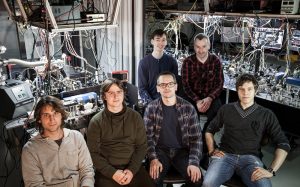The scientists from the Quantum Memories Laboratory of UW have used a group of laser-cooled atoms as a memory which can store simultaneously up to 665 quantum states of light.
Every information processing task requires a memory. As any classical computer cannot exist without a RAM memory, quantum computer could not be built without a quantum memory. Quantum memory is a device capable of storage and on demand retrieval of quantum states. The key parameter of such memory is its capacity, in other words the number of qubits (quantum bits) which the memory can effectively process. Simultaneous operation on many qubits is a key to efficient quantum parallel computation, providing new possibilities in the fields on imaging or communication.
Among many methods of encoding information about single photons in a quantum memory the spatial multiplexing aided by a single-photon sensitive camera stands out as an effective way to obtain high capacity at low cost. In the Quantum Memories Laboratory of the Faculty of Physics, University of Warsaw, such high-capacity memory has been successfully built. The system now holds a world-record of the largest capacity, as other experimentalists can only harness tens of independent states of light.
The heart of the constructed setup comprises a so-called magneto-optical trap (MOT): a group of rubidium atoms inside a glass vacuum chamber is trapped and cooled by lasers in the presence of magnetic field to about 20 microkelvins. The memory light-atoms interface is based on off-resonant light scattering. In the write-in process the cloud of atoms is illuminated by a laser beam, resulting in photon scattering. Each scattered photon is emitted in random direction and registered on a sensitive camera. The information about scattered photons is stored inside the atomic ensemble in the form of collective excitations – spin-waves which can be on demand retrieved as another group of photons. By measuring correlations between emission angles of photons created during the write-in and read-out process we certify that the memory is indeed quantum and that the properties of generated state of light fail to be described by classical optics.
The experimental results have been published in a prestigious Nature Communications journal. The article entitled “Wavevector multiplexed atomic quantum memory via spatially-resolved single-photon detection” has been written by UW scientists: M. Parniak, M. Dąbrowski, M. Mazelanik, A. Leszczyński, Michał Lipka and Dr. Wojciech Wasilewski.




